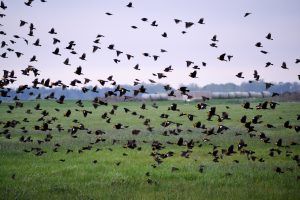
When the nearly 500,000 sandhill cranes migrate on from Nebraska, their absence can leave the Crane Trust a seemingly very quiet place. You’d never know at a first glance that Crane Trust researchers have detected 148 bird species across the property since March began. The grand total for the property is nearly 225 species since the 1980s.
Some of the most interesting species the Trust has been visited by in the past few months include: wood thrush, stilt sandpiper, scarlet tanager, marbled godwit, blue-gray gnatcatcher, black-and-white warbler, palm warbler, and of course the whooping crane. Many more species have yet to pass through in the next two weeks or so before breeding season is in full swing. Nebraska is a magical place at this time of year where every day you could get a new migrant that is just stopping by on its way to nest.
Right now we’re seeing peak warbler migration with a sharp down-turn in duck migration. Other forest birds like flycatchers and vireos are on the rise as well. Thrushes, swallows, and shorebirds have gone through the area in high numbers, and are beginning to settle into their breeding habitats. While early nesting species like mourning doves, killdeer, and robins are already tending their eggs.
Just this year, five new species were documented on Crane Trust properties that haven’t been recorded here before. These include: Bonaparte’s gull, horned grebe, scarlet tanager, snowy egret, and wood thrush. Current research at the Crane Trust is allowing us to detect changes over time in the bird community, and because of the work of previous researchers we can compare species presence and abundance from now to data collected 35 years ago. This allows us to see what birds have shifted their ranges, and what birds have declined. This type of research is vital to understanding how the world around us is changing, and what we can do about it.
Everyone can participate in long-term monitoring, especially when it comes to birds. Global Big Day is May 14th, and all you have to do to participate is go outside and record how many of each bird species you see and then submit it to eBird.org. Big counts like this can alert us to when a particular species, like the Whooping Crane, Piping Plover, or Least Tern is in need of listing for protection. All you have to do is get out there!

